Ångström Femtosecond Laser Laboratory
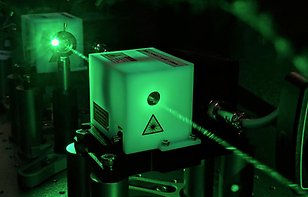
About the Laboratory
Our laboratory is a new user facility which is specially designed for cutting-edge experiments in the field of material science. Hosted at FREIA , the facility provides unique opportunities to users who are focused on physics of non-equilibrium and highly correlated systems in condensed and soft matter states. Experiments for both stand-alone projects as well as for separate tasks within third-party agreements are possible.
For this, we offer a laser system capable of generating nearly Fourier-limited pulses over a broad spectral range, starting from the vacuum ultraviolet down to the deep mid infrared. By utilizing an optical pump-probe technique, we can strobe the dynamics of material response with femtosecond time resolution. More specifically, our two experimental stations enable time- and Angle-Resolved Photo-Emission Spectroscopy (tr-ARPES) and time-resolved Magneto-Optic Kerr Effect (tr-MOKE).
We are open for everyone who is interested in the photo-induced phase transitions, light-induced super-conductivity, ultrafast charge transfer, and low-dimensional material characterization. Also, we are ready for collaboration in the field of applied nonlinear and coherent optics, including the development of light sources.
We invite graduate and undergraduate students to conduct their research as part of Bachelor, Master and PhD projects.
Lab photos
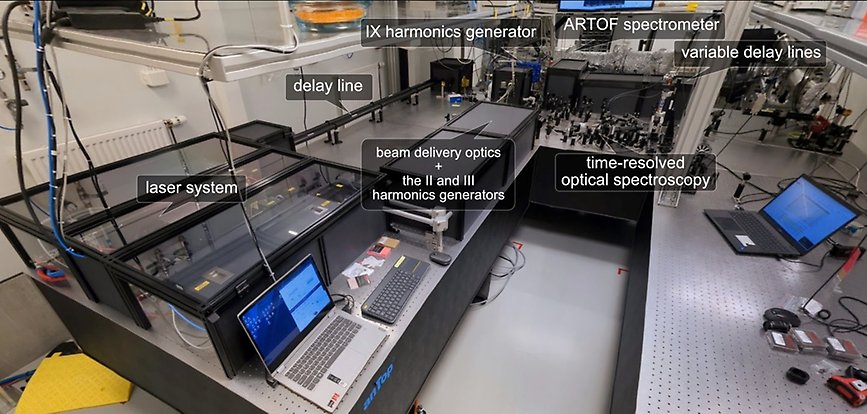
Ångström femtosecond laser laboratory: laser system side view
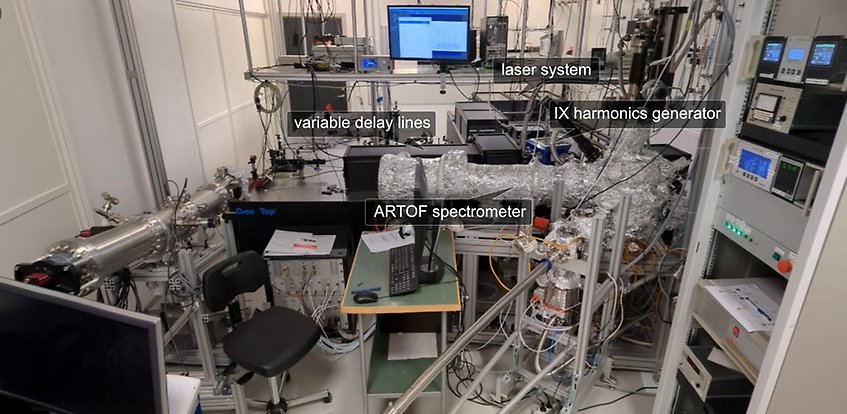
Ångström femtosecond laser laboratory: side view from the Photo-Emission Spectroscopy Station
Laser System
The laser system comprises industrial-grade femtosecond laser CARBIDE-CB3-80W, Light Conversion UAB. The laser generates pulses with duration of less than 200 fs with the pulse repetition rate (PRR) from several Hz to 2 MHz and average power of up to 80 W at the wavelength of about 1030 nm (1.2 eV photon energy).
Approximately half of the laser power is used to pump optical parametric amplifier (OPA) ORPHEUS-ONE-HP, Light Conversion UAB. The OPA produces a spectrally-tuneable train of femtosecond pulses within the wavelength range of 0.66 – 16 um (1.88 – 0.077 eV) with maximum pulse energy of 50 mJ at the 1.55 um (0.8 eV). An external pulse picker, installed between the OPA and CARBIDE laser, makes it possible to further configure the OPA pulse tains. This provides flexibility in implementation of specific types of the pump-probe experiments.
The rest power of the CARBIDE laser is dedicated to the needs of users and for generation of higher harmonics. Specifically, we use the CARBIDE’s 9th harmonics (114 nm, 10.8 eV) as a probe beam for the photoemission experiments. To generate this harmonics, we apply frequency doubling and mixing of fundamental harmonics in nonlinear crystals and subsequent frequency tripling in noble gases. Such an approach has been recently adopted for high-resolution ARPES at the T-ReX laboratory.
harmonics | fundamental | II | III | IX |
|---|---|---|---|---|
center wavelength, nm | 1030 | 515 | 343 | 114 |
highest mean output power @120 kHz PRR | 80 W | 45 W | 8 W | 20 uW |
long-term power variation, % RMS | 0.1 | 0.15 | 0.25 |
|
pulse duration FWHM, fs* | 190 - 200 | 190 - 230 | 250 - 300 | 600-800 |
tuning range, nm | 660 - 850 | 1350 - 2000 | 2000 - 4000 | 4000 - 16000 |
|---|---|---|---|---|
pulse energy, upto uJ | 4 | 50 | 30 | 4 |
pulse duration FWHM, down to fs | <250 | 150 - 310 |
|

CARBIDE-CB3 laser and ORHEUS-ONE-HP optical parametric amplifier
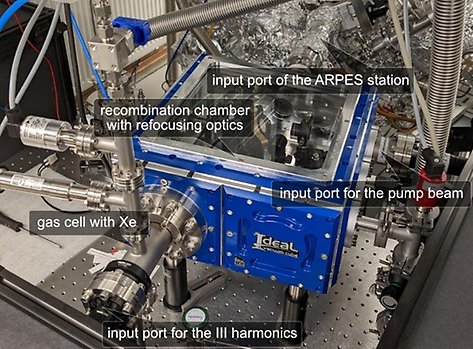
The IX harmonic generator and recombination chamber
Experimental Stations
time- and Angle-Resolved Photo-Emission Spectroscopy (tr-ARPES)
A heart of the ARPES station is the Angle-Resolved Time-of-Flight spectrometer ARTOF 2 , Scienta Omicron AB. In contrast to hemispherical electron analyzers, the ARTOF allows 2D band mapping experiments without performing rotation of the sample. This is possible because of the operating principle of the ARTOF where trajectories of electrons are analyzed over a solid cone, with both energy and angular resolution. The maximum acceptance angle is ±15°. Being used with our lasers, the ARTOF allows about 20 meV energy resolution. The current configuration implies nearly collinear pump and probe laser beams with a sample surface oriented at an angle of about 25±10 relative to beam axes. An optical imaging system and 4-axis manipulator provide necessary translational and angular alignment of samples. Soon, the manipulator will be equipped with a helium flow cryostat that allows operation temperatures down to 6 K.
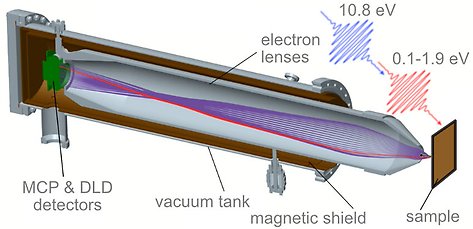
Illustration of operation principle for the pump-probe experiments with ARTOF
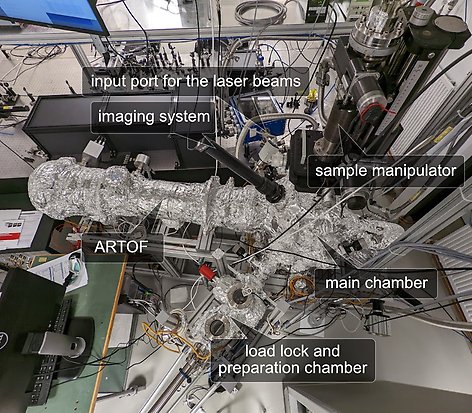
Top view of the ARPES station
Time-Resolved Magneto-Optic Kerr Effect (tr-MOKE)
Currently, the station allows high-sensitive optical pump-probe polar MOKE experiments in the reflection geometry. For the probe beams in visible and near-infrared spectral regions, detection of the Kerr rotation as small as 0.003 mrad in the polarization channel is proved by using low-noise balanced photodetection and digital lock-in amplification. In the intensity channel, relative change down to 0.002% is reliably detected. This, together with cryocooling down to temperature 3.5 K, makes it possible to study efficiently transient interaction of optical phonons and electron spins in the 2D ferromagnets and van der Waals materials.
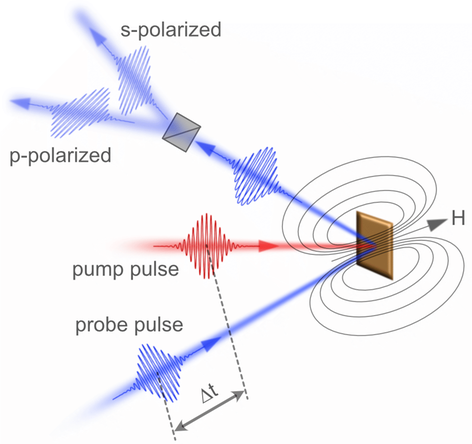
Illustration of operation principle for the time-resolved polar MOKE
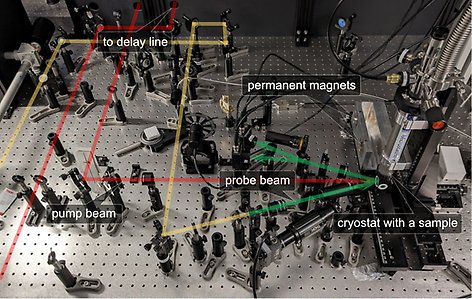
Top view of the tr-MOKE setup
Collaboration
T-Rex group and Prof. Fulvio Parmigiani
Group of Assoc. Prof. Venkata Kamalakar Mutta
Group of Prof. Gabriella Andersson
Group of Prof. Vassilios Kapaklis
Find us here
We are hosted at FREIA laboratory, Polacksbacken Campus, Lägerhyddsvägen 1, Uppsala

Contact
- Programme Professor:
- Hermann Dürr
- Primary responsible:
- Ruslan Chulkov
